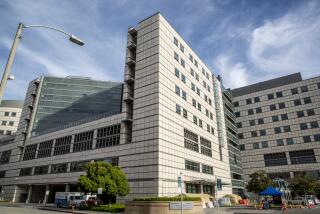Worry over flu spurs change at County-USC
- Share via
Los Angeles County-USC Medical Center has become too overcrowded to handle the expected surge of H1N1 flu patients in coming months, county leaders said this week as they forced hospital officials to reduce wait times by transferring patients more quickly.
The crowd waiting for emergency room beds at County-USC often swells to 100, some waiting up to 24 hours, Supervisor Gloria Molina said. Recent county reports show that 30% to 40% of the time the hospital is operating at “severely” and “dangerously” overcrowded levels.
Molina visited the hospital Monday night and met with about 40 families, most of whom had children. She said she talked to at least three patients who had been waiting 23 hours.
“If H1N1 becomes the kind of pandemic that they think it may be, what you will have at L.A. County-USC is people in gurneys in the hallways; that’s the only capability they have,” Molina said. “They are at a point where they are going to be overtaxed.”
County-USC officials insisted that the number of patients waiting for emergency beds has been lower in recent weeks, 37 to 87 on average. They said the average wait time for the emergency room was three to 16 hours.
But they conceded that emergency rooms at all three county hospitals have become crowded in recent months amid the poor economy as workers have lost their jobs and health insurance, and have begun to fall back on the county health system.
At Molina’s urging, supervisors Tuesday directed County-USC officials to transfer patients when more than 13 are waiting for emergency room beds or when the average wait time in the emergency room reaches 11 hours. County health officials estimate that the new policy will cost $2.5 million annually, mostly for the care of indigent patients and those without private health insurance or Medi-Cal.
County-USC already contracts with St. Vincent Medical Center in Los Angeles and several other private hospitals that honor Medi-Cal, and is negotiating contracts so they can transfer patients to more hospitals, according to Carol Meyer, chief network officer of the county Department of Health Services.
Patient volume increased 17% at County-USC, 25% at Harbor-UCLA Medical Center and 7% at Olive View-UCLA Medical Center from 2007 to 2008, Meyer said, citing the most recent figures available.
“As the economy has gotten worse over the past year, we know those percentages have gone up,” she said. “We are dealing with a very busy situation in our emergency rooms, and we have taken many extra measures to be prepared.”
County-USC officials said they have tents on hand and extra staff on call in case they see an influx of H1N1 patients.
“Hospitals in this area have been working together to plan for this type of pandemic for years,” said County-USC Chief Executive Peter Delgado. “We feel we’re pretty ready.”
The bed crunch is not confined to public hospitals. Demand for hospital beds increased 5% to 15% countywide last summer compared with the same period last year, said Jim Lott, executive vice president of the Hospital Assn. of Southern California.
Lott said H1N1 flu patients are going to need longer-term hospital beds, not just temporary or emergency room beds, and recent association surveys show Los Angeles County is 215,000 beds short.
“Tents don’t work for critical care,” he said.
Before the new County-USC was built nearly a year ago, Molina lobbied hard to maintain at least 750 beds. She lost, the number was reduced to 600, including about 100 emergency beds, and the hospital has been overcrowded since it opened, transferring about 130 patients a month to Rancho Los Amigos National Rehabilitation Center in Downey. Crowding intensified as other local emergency rooms closed.
“Right now they think they can accommodate it,” Molina said. “But let’s face it -- it was built too small.”
--
molly.hennessy-fiske @latimes.com
More to Read
Sign up for Essential California
The most important California stories and recommendations in your inbox every morning.
You may occasionally receive promotional content from the Los Angeles Times.











